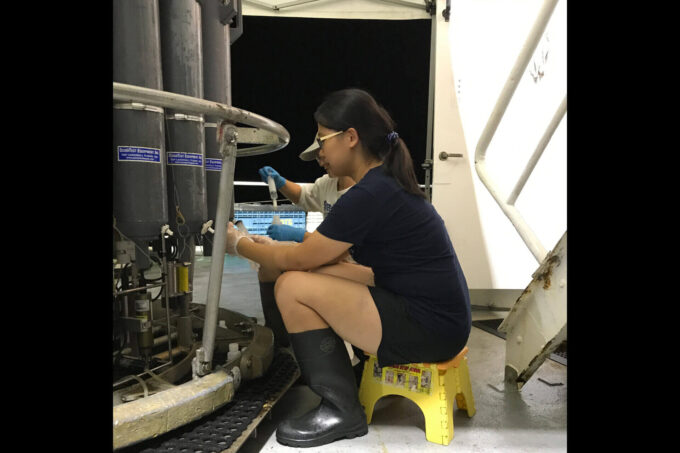Ancient atmospheric oxygen sleuthing with ocean chromium

Findings show how the trace metal is chemically altered in the anoxic, modern ocean and provide the basis for investigating paleorecords of atmosphere composition shifts.
Read this at MIT News
Found in jewelry, car parts, pigments, and industrial chemical reactions, the metal chromium and its compounds are often employed for their color, finish, anti-corrosive and catalytic properties. Currently, geoscientists and paleoceanographers from MIT and the Woods Hole Oceanographic Institution (WHOI) are looking to add another use to that list: as a way to examine chemical shifts in ancient Earth’s oceans and atmosphere that are preserved in the seafloor’s paleorecord. More specifically, they want to reconstruct rising atmospheric oxygen levels, which began around 2.4 billion years ago, and their effect on the seas. Since biology and the environment are intimately intertwined, this information could help illuminate how the Earth’s life and climate evolved.
While researchers have widely applied chromium as a tool to understand the rock record around this global transition, they’re still working out what different chemical signals mean. This is especially true for evaluating ocean sediments, which could reveal where and when oxygen began penetrating and was being formed in the oceans. However, paleoscientists have largely lacked an understanding of how trace amounts of chromium mechanistically interact and cycle in modern, oxygenated seas, let alone the early oceans—a key component needed for any interpretation—until now.
New research, published in the Proceedings of the National Academy of Sciences and led by MIT-WHOI Joint Program graduate student Tianyi Huang, investigated the trace metal’s promise as a paleoproxy for oxygen. For this, the team tracked how oxygen-sensitive chromium isotopes circulated and how they were chemically oxidized or reduced within an oxygen-deficient patch of water in the tropical Pacific Ocean, an analog for early, anaerobic seas. Their findings help validate chromium tracking as a reliable instrument in geology toolbox.
“People have seen the that chromium isotopes in the geological records kind of track the atmospheric oxygen levels. But, because you’re using something that is buried in the sediments to interpret what is happening in the atmosphere, there’s a missing link in between, and that is the ocean,” says Huang. Further, “how that chromium cycles might change our interpretations of geological records.”
“The evolution of oxygen on Earth is only known in a coarse fashion, but it is crucial to the development and survival of complex multicellular life,” says Ed Boyle, Professor of Ocean Geochemistry of MIT’s Department of Earth, Atmospheric and Planetary Sciences (EAPS); MIT-WHOI Joint Program Director; and study co-author, along with Simone Moos PhD ’18 of the Elementar Corporation. “In addition, there is ongoing concern about the past few decades of decreasing oceanic oxygen levels in the ocean, and we need tools to better understand the ocean’s oxygen dynamics.”
Bridging a gap
Billions of years ago, when Earth and its atmosphere were essentially devoid of molecular oxygen (O2), unlike today, chemical reactions and biological metabolisms would have occurred in a chemically reduced, anaerobic environment. During the Great Oxidation Event (GOE), which occurred over the course of millions of years, oxygen levels rose planet-wide, and life transitioned accordingly. Further, the environment largely became an oxidized one, that grappled with stress processes like rusting and free radicals.
Some evidence has shown that chemical reactions involving chromium track this process, through effects on its isotopes, chromium-52 and chromium-53, and their oxidation states, primarily the trivalent, reduced form Cr (III) and a hexavalent, oxidized one Cr (VI). The latter of which is more likely to be found in oxygenated, surface seawater and is considered a health and environmental hazard. Previous studies have shown that the upper ocean tends to have more of the heavier isotope than the lighter one, suggesting some preferential uptake by marine microorganisms. The problem, Huang notes, is that after chromium enters the oceans from rivers, scientists don’t really know the mechanisms behind these observations and if the trends are consistent. In today’s oxygen-deficient waters, she says, “chromium could potentially be reduced, and we want to know the isotope signal of that and other chromium processes that might leave an isotope fingerprint.”
To investigate these phenomena, Huang joined two research cruises to the eastern tropical North Pacific Ocean’s oxygen-deficient zone (ODZ) and gathered vertical profiles of seawater samples down to 3,500 meters from across a transect of sea. Some of these seawater samples were frozen to be analyzed for concentrations of trivalent and hexavalent chromium. After being shipped back to the lab, these samples were thawed and purified. The team analyzed the isotope composition of the Cr (III) samples. They then acidified the Cr (VI) samples to convert them to Cr (III) before performing the same isotope analysis as before. The researchers also measured the total chromium in the samples to be able to account for any chemical transformations or migration within the ODZ. With the addition of data from another cruise, Boyle, Moos, and Huang examined the fraction of each isotope over the depth range, compared to an average partitioning, to see if there was any enrichment in a particular area of the ODZ and which oxidation state it existed in. They charted this against the samples’ oxygen levels and put the results in context of known ocean features to help explain how chromium is cycling.
A ground-truth for chromium cycling
The oceanographers found a pattern. In surface, oxygenated ocean, hexavalent chromium was consumed, likely by microbial life, and transported deeper, into the ODZ. Around the 200-meter mark, the metal began to accumulate in the seawater, and the lighter isotope, chromium-52, was preferentially reduced. This depth happens to coincide with anaerobic, denitrifying microbes that produce nitrite. Huang says that this could be a sign that nitrogen and chromium cycling are entangled, but that doesn’t rule out other biotic or abiotic mechanisms, like reduction by iron, that could be affecting ocean sediment records.
Chromium doesn’t linger here forever though. While data showed that most of it remained in oxygen-deficient zone, which extends from 90 to 800 meters, for about 20-50 years, a small portion of it attached to sinking particles, sunk into the deep ocean where there is more dissolved oxygen, and later oxidized back to hexavalent chromium. Here, it could begin incorporating and interacting with sediments.
“I think it is exciting that we could determine the chromium [oxidation] species, and from that, we could calculate its isotope fractionation,” says Huang. “Nobody has done that in this way before.”
Their work, Huang says, helps validate chromium as an indicator of different redox environments. “We’re seeing this signal and it’s not vanishing.” Further, it seems consistent over the seasons. However, the team isn’t convinced yet. They plan to test this in other oxygen deficient zones around the world to see if a similar chromium signature pops up, as well as investigate the composition of the sinking particles carrying the trivalent chromium and the surface of ocean sediments, in order to get a more complete picture of the ocean’s involvement. For now, they advise against drawing conclusions, but are guardedly optimistic about its potential. “I think people need to interpret this proxy with more caution,” says Huang. “It might not be purely the atmospheric oxygen that is determining the measurement, but there could be other [biotic or abiotic] processes in the ocean that could alter their paleorecords.” So, they suggest not to read into the chromium signals in the paleorecord too much, yet.
This research was supported, in part by the National Science Foundation.
Story Image: Tianyi Huang taking seawater samples from Niskin bottles. (Credit: Kelsy Cain)


